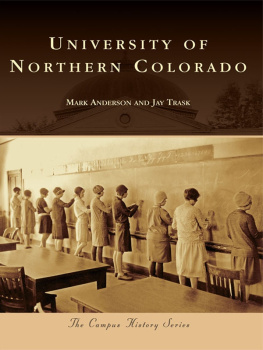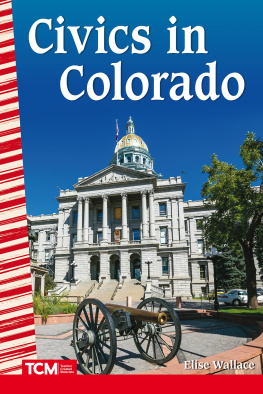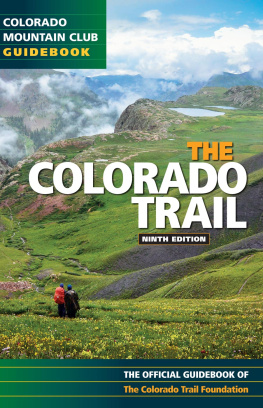CHRONICLES
OF
COLORADO

FRANCIS PARKMAN HORACE GREELEY
MARK TWAIN WALT WHITMAN ZANE GREY
SAMUEL BOWLES HELEN HUNT JACKSON
EMILY FAITHFULL RUDYARD KIPLING
ENOS MILLS THEODORE ROOSEVELT.
Selected and Introduced by
FREDERICK R. RINEHART.

for Alex and C. C.
and in memory of Tom Auer, editor extraordinaire
Copyright 2003 by Frederick R. Rinehart
All rights reserved. No part of this book may be reproduced in any form or by any electronic or mechanical means, including information storage and retrieval systems, without written permission from the publisher, except by a reviewer who may quote passages in a review.
Taylor Trade
A Roberts Rinehart Book
A wholly owned subsidiary of The Rowman & Littlefield Publishing Group, Inc.
4501 Forbes Boulevard, Suite 200
Lanham, MD 20706
Distributed by National Book Network
A previous edition of this book was previously cataloged by the Library of Congress as follows:
Rinehart, Frederick R. (Frederick Roberts), 1953
Chronicles of Colorado / selected and introduced by Frederick R. Rinehart.
p. cm.
1. Coloradodescription and travel. I. Title.
ISBN 1-58979-045-6 (pbk.: alk. paper)
F776.5 .C5 1984
 The paper used in this publication meets the minimum requirements of American National Standard for Information SciencesPermanence of Paper for Printed Library Materials, ANSI/NISO Z39.48-1992.
The paper used in this publication meets the minimum requirements of American National Standard for Information SciencesPermanence of Paper for Printed Library Materials, ANSI/NISO Z39.48-1992.
Manufactured in the United States of America.

CONTENTS

Gates of Lodore, northwestern Colorado, as rendered by a nineteenth century engraver.

PREFACE TO THE
THIRD EDITION
When I first put this book together twenty years ago, the population of the state of Colorado was approximately 2.8 million souls. James Micheners novel about the state, Centennial, had just been produced as a popular TV miniseries and an oil bust had thrown the local economy into a tailspin, adding credence to the belief that our economy had been historically overly dependent on the fluctuating demand for our vast mineral resources. Centennial itself painted a rather gloomy picture of the future by postulating that our limited water supply could barely support our population. It did not hesitate to suggest that any kind of severe drought would bring an immediate halt to residential and commercial development, and unmercifully kill off what was left of our wounded economy.
One catastrophic drought and 1.5 million people later, Colorado has survived and even prospered. Observing the stateespecially the people of the stateover twenty years has been an inspiring lesson in the ability of people to adapt creatively to ever changing circumstances. Notwithstanding the 30 percent increase in the states population, the Front Range corridor managed to shake its reputation as having some of the dirtiest air of any metropolitan area in the United States. A revolution in regional landscape architecture resulted in the development of greenways that take advantage of what nature gives us along cool and shady riparian woodlands. Xeriscaping has become accepted as a worthy alternative to water-intensive gardening and landscaping. Finally, a highly diversified economic baseconsisting of high tech, manufacturing, tourism, transportation, services, construction, and financehas largely subsumed the traditional yet teetering twin pillars of the Colorado economy, agriculture and mining.
Still, the perspective of twenty years allows a little nostalgia for the good old days, when the drive from Boulder to Denver took you by virtually unfettered fields and the jam ups at the Eisenhower Tunnel on Sunday afternoons were the exception rather than the rule. Eastern Colorado now abounds with bedroom communities, golf courses, and elaborate shopping malls, often obscuring, as I suggested in the 1983 introduction to this book, the sublime landscape that drew us here in the first place. I was wrong about one thing in that essay, though: the land is not, as I haughtily proclaimed, intolerant of the excesses of human habitation. For one thing, tolerance is a human characteristic; for another, although there are more of us, we have significantly curbed our individual excesses. One of the ironies of moving from supposedly idyllic, rural Colorado to a planned community of several hundred homes, as I have in recent years, is that new construction is marvelously efficient in its energy consumption and water use. I now cringe at how we used to flood irrigate our pastures and tolerate smoke-belching farm equipment that was subject to no emissions laws.

More vexing for me over the past two decades has been what I will call (for lack of a better expression) a search for identity. This is not so much a question of whether or not Colorado is a good place to live (it is), but more an exploration of what makes us uniquely Coloradanand what makes Colorado unique. Certainly being the highest state is a cachet that leaves you with the impression that we are the head and shoulders of the continent, looking down our ski-sloped nose on the flattest state or the lowest state. Perhaps one in four Coloradans knows that we are also the Centennial State, owing to our entry into the Union in 1876. Neither moniker, however, alludes to any great cultural tradition that bonds us irrevocably to this land (though I still contend that Colorado geography has shaped us more than we have shaped it). Wyoming is clearly the Cowboy State. Utah has its Mormon traditions. New Mexico prides itself on its Hispanic and Native American heritages. Colorado has ski resorts, a substantial urban strip from Fort Collins to Pueblo, and a really big airport. Indeed, so transient is the social environment of Colorado that our state motto could easily be just passing through.
In rereading the selections in this volume recently, I became aware of how the state seems to redefine itself about once a generation, not terribly surprising for a place with so much mobilityupward, downward, outward, inward. To Francis Parkman (1846) it was an unfriendly place that one hurried to get through. Thirteen years later the discovery of gold and silver moved Horace Greeley to observe, All is now being rapidly changed, and not entirely for the better. By 1879 Colorado had within it a strong urban presence, with Walt Whitman marveling over the salubrious atmosphere of Denver: there has steadily grown upon me a feeling of affection for the spot. In the early twentieth century, with civilization well established on the eastern plains and a ski industry still years from development, Zane Grey, Theodore Roosevelt, and Enos Mills shifted the focus to the Colorado wilderness, a golden era for the outdoorsman if there ever was one.







 The paper used in this publication meets the minimum requirements of American National Standard for Information SciencesPermanence of Paper for Printed Library Materials, ANSI/NISO Z39.48-1992.
The paper used in this publication meets the minimum requirements of American National Standard for Information SciencesPermanence of Paper for Printed Library Materials, ANSI/NISO Z39.48-1992.

